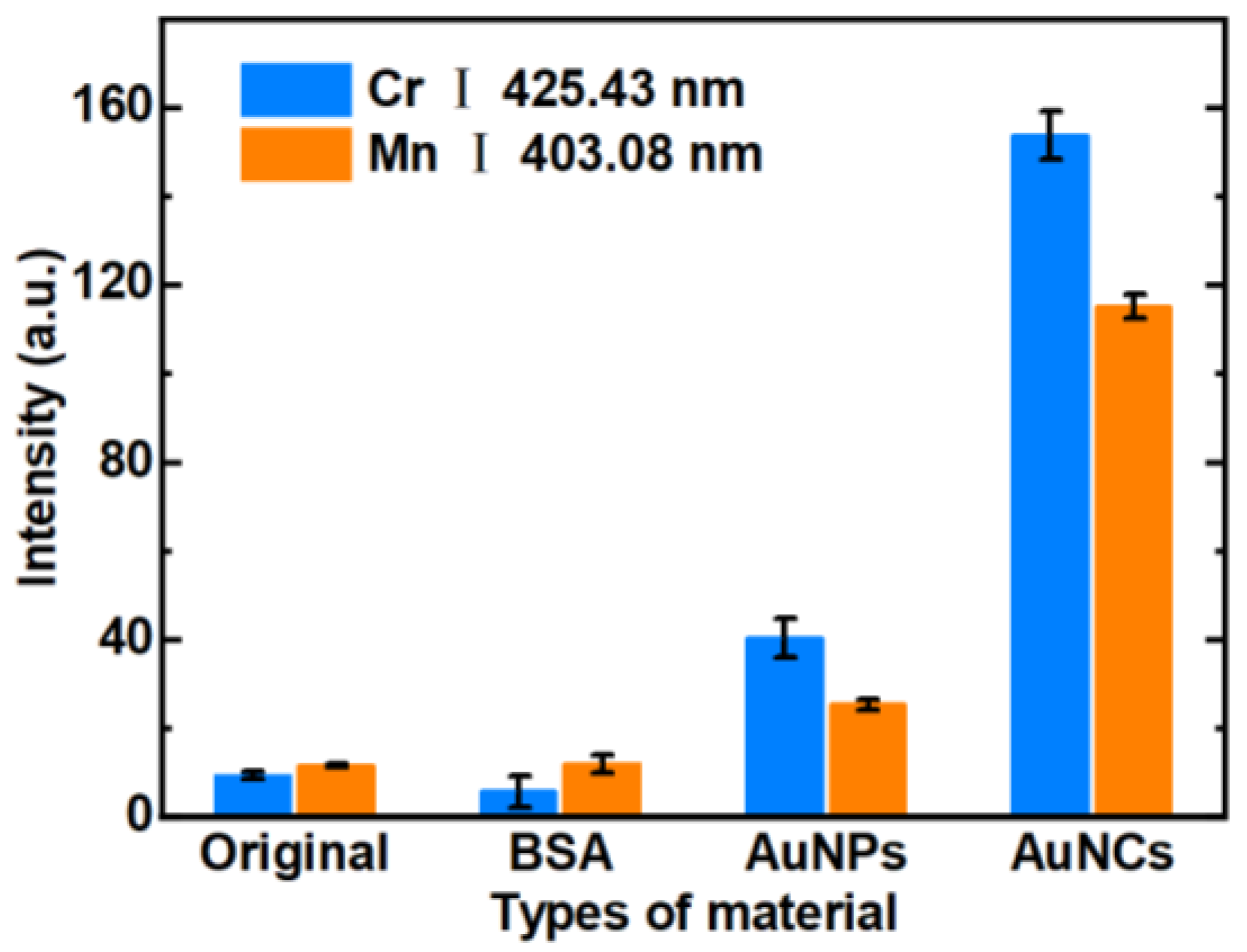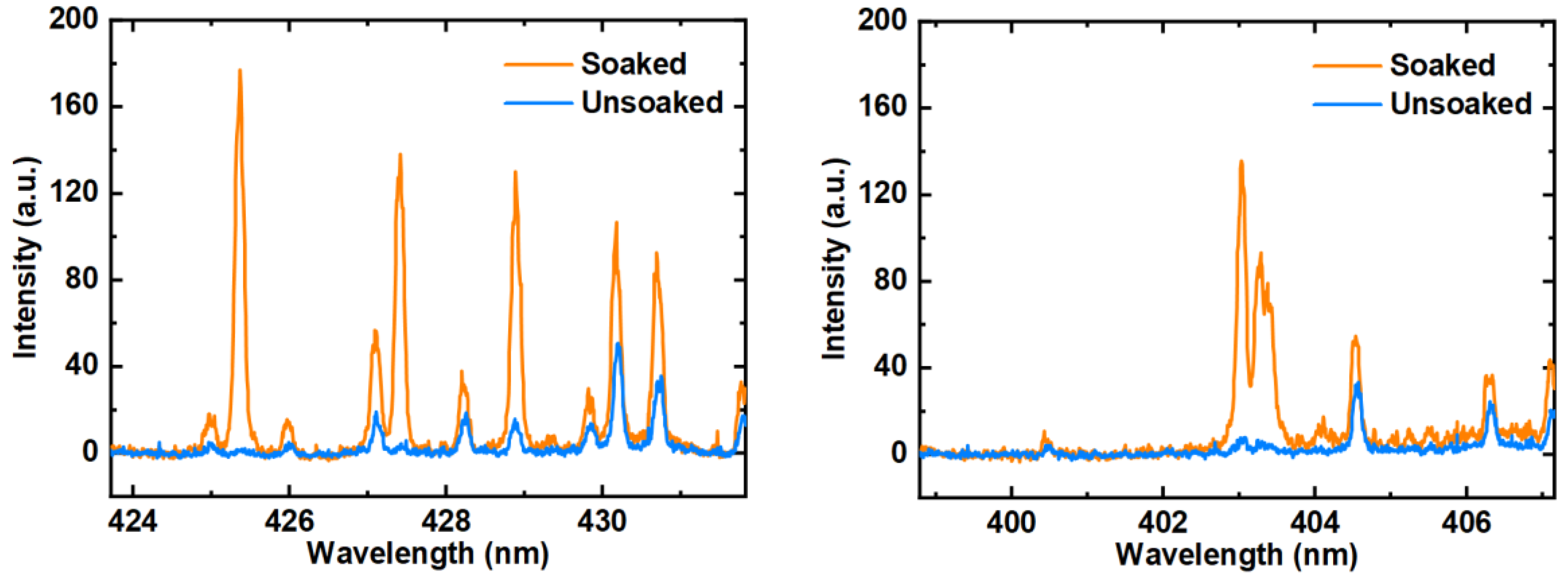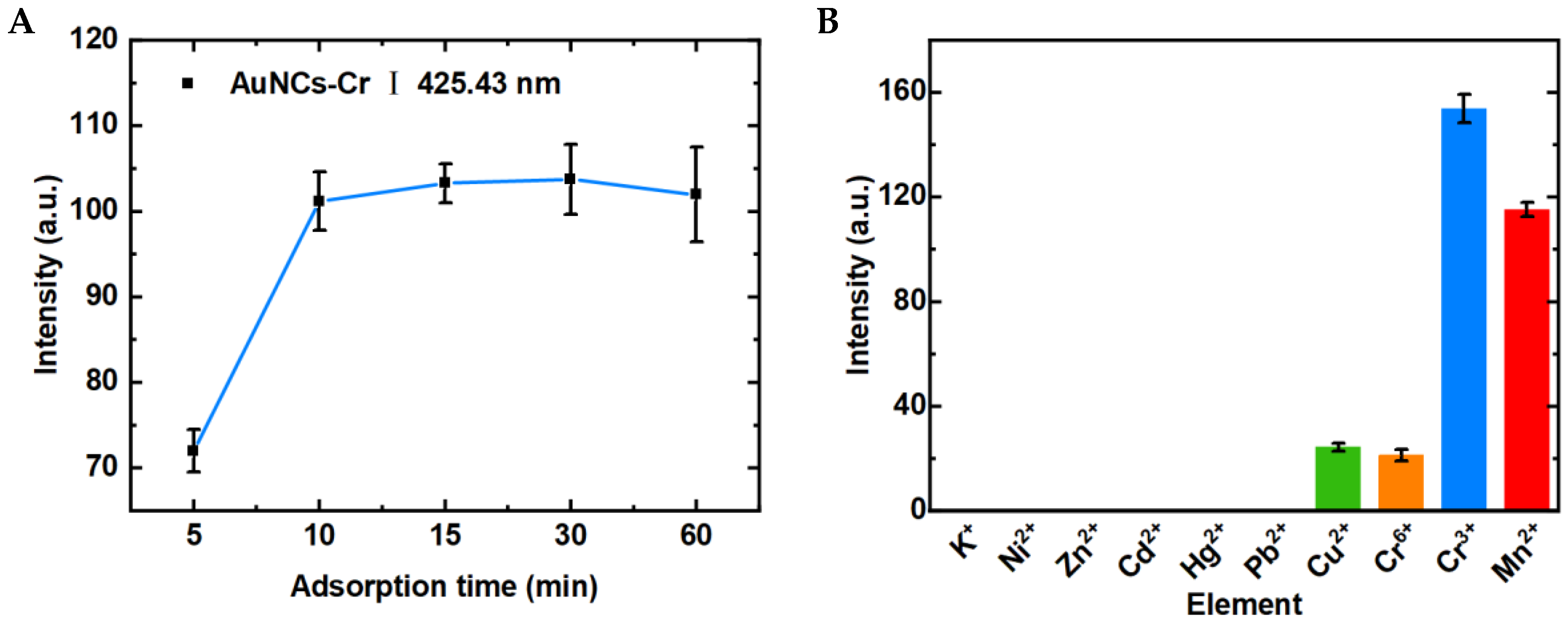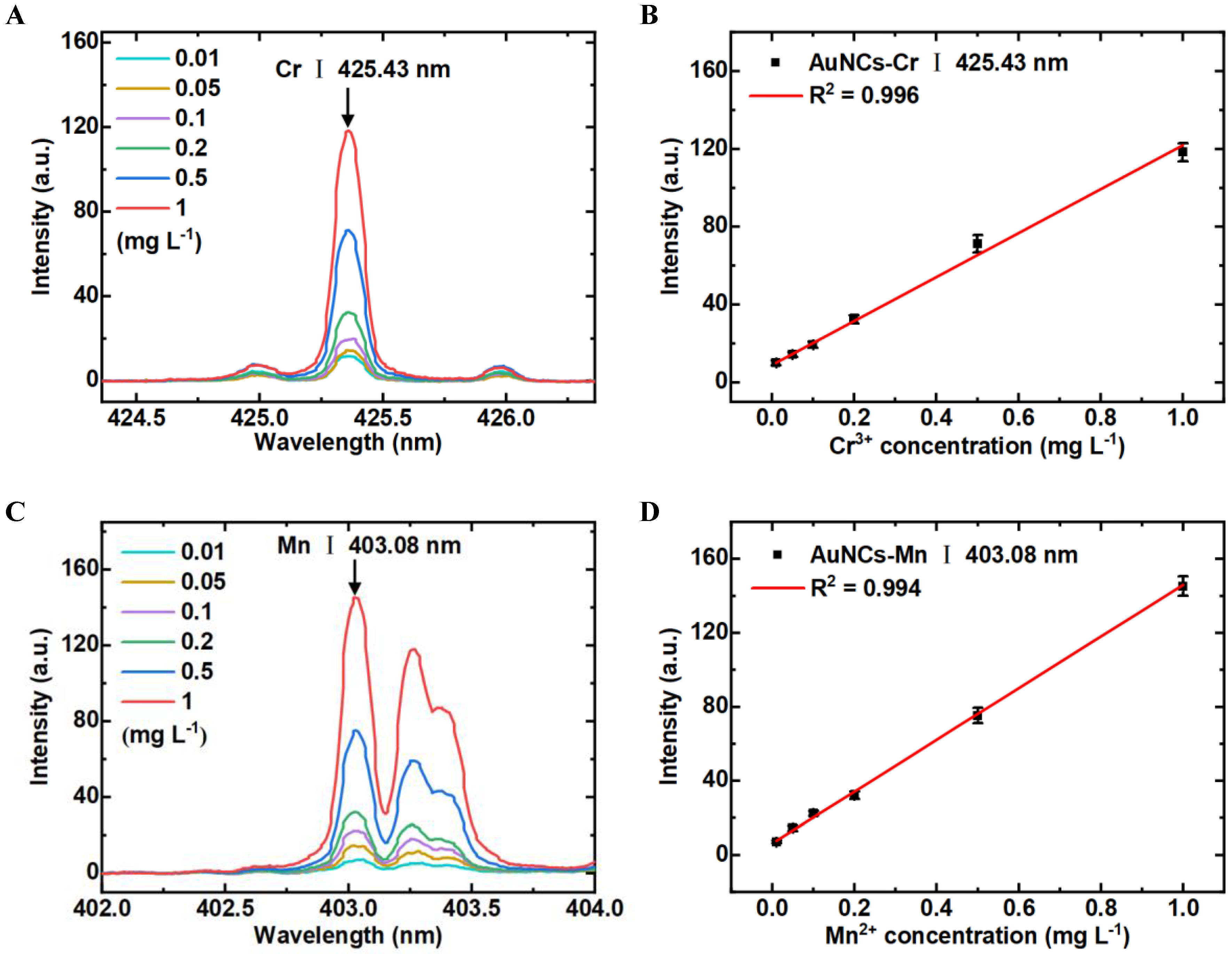Rapid Determination of Cr3+ and Mn2+ in Water Using Laser-Induced Breakdown Spectroscopy Combined with Filter Paper Modified with Gold Nanoclusters
Abstract
:1. Introduction
2. Materials and Methods
2.1. Materials and Instrumentation
2.2. Preparation of AuNCs and AuNPs Modified Filter Paper
2.3. LIBS-FP-AuNCs Sensor for Cr3+ and Mn2+ Detection
3. Results and Discussion
3.1. Comparison of Adsorption Capabilities of Filter Papers Modified with Different Materials
3.2. Characterization of AuNCs-Modified Filter Paper
3.3. Optimization of Experimental Conditions
3.4. LIBS-FP-AuNCs for Multi-Element Detection
3.5. Detection Sensitivity of LIBS-FP-AuNCs for Cr3+ and Mn2+ Analysis
3.6. Determination of Cr3+ and Mn2+ Ions in Real Samples
4. Conclusions
Author Contributions
Funding
Institutional Review Board Statement
Informed Consent Statement
Data Availability Statement
Conflicts of Interest
References
- Vareda, J.P.; Valente, A.J.M.; Durães, L. Assessment of Heavy Metal Pollution from Anthropogenic Activities and Remediation Strategies: A Review. J. Environ. Manage. 2019, 246, 101–118. [Google Scholar] [CrossRef] [PubMed]
- Shao, X.; Huang, B.; Zhao, Y.; Sun, W.; Gu, Z.; Qian, W. Impacts of Human Activities and Sampling Strategies on Soil Heavy Metal Distribution in a Rapidly Developing Region of China. Ecotoxicol. Environ. Saf. 2014, 104, 1–8. [Google Scholar] [CrossRef] [PubMed]
- Kumar, V.; Parihar, R.D.; Sharma, A.; Bakshi, P.; Singh Sidhu, G.P.; Bali, A.S.; Karaouzas, I.; Bhardwaj, R.; Thukral, A.K.; Gyasi-Agyei, Y.; et al. Global Evaluation of Heavy Metal Content in Surface Water Bodies: A Meta-Analysis Using Heavy Metal Pollution Indices and Multivariate Statistical Analyses. Chemosphere 2019, 236, 124364. [Google Scholar] [CrossRef] [PubMed]
- Chen, M.; Qin, X.; Zeng, G.; Li, J. Impacts of Human Activity Modes and Climate on Heavy Metal “Spread” in Groundwater Are Biased. Chemosphere 2016, 152, 439–445. [Google Scholar] [CrossRef] [PubMed]
- Peng, J.; Zhang, S.; Han, Y.; Bate, B.; Ke, H.; Chen, Y. Soil Heavy Metal Pollution of Industrial Legacies in China and Health Risk Assessment. Sci. Total Environ. 2022, 816, 151632. [Google Scholar] [CrossRef] [PubMed]
- Qing, X.; Yutong, Z.; Shenggao, L. Assessment of Heavy Metal Pollution and Human Health Risk in Urban Soils of Steel Industrial City (Anshan), Liaoning, Northeast China. Ecotoxicol. Environ. Saf. 2015, 120, 377–385. [Google Scholar] [CrossRef] [PubMed]
- Zheng, S.; Wang, Q.; Yuan, Y.; Sun, W. Human Health Risk Assessment of Heavy Metals in Soil and Food Crops in the Pearl River Delta Urban Agglomeration of China. Food Chem. 2020, 316, 126213. [Google Scholar] [CrossRef] [PubMed]
- Bjørklund, G.; Chartrand, M.S.; Aaseth, J. Manganese Exposure and Neurotoxic Effects in Children. Environ. Res. 2017, 155, 380–384. [Google Scholar] [CrossRef] [PubMed]
- Martins, A.C.; Krum, B.N.; Queirós, L.; Tinkov, A.A.; Skalny, A.V.; Bowman, A.B.; Aschner, M. Manganese in the Diet: Bioaccessibility, Adequate Intake, and Neurotoxicological Effects. J. Agric. Food Chem. 2020, 68, 12893–12903. [Google Scholar] [CrossRef]
- Mortada, W.I.; El-Naggar, A.; Mosa, A.; Palansooriya, K.N.; Yousaf, B.; Tang, R.; Wang, S.; Cai, Y.; Chang, S.X. Biogeochemical Behaviour and Toxicology of Chromium in the Soil-Water-Human Nexus: A Review. Chemosphere 2023, 331, 138804. [Google Scholar] [CrossRef]
- Tüzen, M. Determination of Heavy Metals in Soil, Mushroom and Plant Samples by Atomic Absorption Spectrometry. Microchem. J. 2003, 74, 289–297. [Google Scholar] [CrossRef]
- Tuzen, M.; Soylak, M. Multi-Element Coprecipitation for Separation and Enrichment of Heavy Metal Ions for Their Flame Atomic Absorption Spectrometric Determinations. J. Hazard. Mater. 2009, 162, 724–729. [Google Scholar] [CrossRef] [PubMed]
- Fernández-Martínez, R.; Rucandio, I.; Gómez-Pinilla, I.; Borlaf, F.; García, F.; Larrea, M.T. Evaluation of Different Digestion Systems for Determination of Trace Mercury in Seaweeds by Cold Vapour Atomic Fluorescence Spectrometry. J. Food Compos. Anal. 2015, 38, 7–12. [Google Scholar] [CrossRef]
- Wu, H.; Wang, X.; Liu, B.; Liu, Y.; Li, S.; Lu, J.; Tian, J.; Zhao, W.; Yang, Z. Simultaneous Speciation of Inorganic Arsenic and Antimony in Water Samples by Hydride Generation-Double Channel Atomic Fluorescence Spectrometry with on-Line Solid-Phase Extraction Using Single-Walled Carbon Nanotubes Micro-Column. Spectrochim. Acta Part B At. Spectrosc. 2011, 66, 74–80. [Google Scholar] [CrossRef]
- Pereira, J.S.F.; Moraes, D.P.; Antes, F.G.; Diehl, L.O.; Santos, M.F.P.; Guimarães, R.C.L.; Fonseca, T.C.O.; Dressler, V.L.; Flores, É.M.M. Determination of Metals and Metalloids in Light and Heavy Crude Oil by ICP-MS after Digestion by Microwave-Induced Combustion. Microchem. J. 2010, 96, 4–11. [Google Scholar] [CrossRef]
- Tokalıoğlu, Ş. Determination of Trace Elements in Commonly Consumed Medicinal Herbs by ICP-MS and Multivariate analysisICP-MS. Food Chem. 2012, 134, 2504–2508. [Google Scholar] [CrossRef] [PubMed]
- Khan, S.R.; Sharma, B.; Chawla, P.A.; Bhatia, R. Inductively Coupled Plasma Optical Emission Spectrometry (ICP-OES): A Powerful Analytical Technique for Elemental Analysis. Food Anal. Methods 2022, 15, 666–688. [Google Scholar] [CrossRef]
- Bozorgzadeh, E.; Pasdaran, A.; Ebrahimi-Najafabadi, H. Determination of Toxic Heavy Metals in Fish Samples Using Dispersive Micro Solid Phase Extraction Combined with Inductively Coupled Plasma Optical Emission Spectroscopy. Food Chem. 2021, 346, 128916. [Google Scholar] [CrossRef] [PubMed]
- Fortes, F.J.; Moros, J.; Lucena, P.; Cabalín, L.M.; Laserna, J.J. Laser-Induced Breakdown Spectroscopy. Anal. Chem. 2013, 85, 640–669. [Google Scholar] [CrossRef]
- Cao, F.; Jiao, F.; Ma, S.; Dong, D. Laser-Induced Breakdown Spectroscopy Mediated Amplification Sensor for Copper (II) Ions Detection Using Click Chemistry. Sens. Actuators B Chem. 2022, 371, 132594. [Google Scholar] [CrossRef]
- Cremers, D.A.; Chinni, R.C. Laser-Induced Breakdown Spectroscopy—Capabilities and Limitations. Appl. Spectrosc. Rev. 2009, 44, 457–506. [Google Scholar] [CrossRef]
- Yi, R.; Yang, X.; Zhou, R.; Li, J.; Yu, H.; Hao, Z.; Guo, L.; Li, X.; Lu, Y.; Zeng, X. Determination of Trace Available Heavy Metals in Soil Using Laser-Induced Breakdown Spectroscopy Assisted with Phase Transformation Method. Anal. Chem. 2018, 90, 7080–7085. [Google Scholar] [CrossRef] [PubMed]
- Zhu, C.; Tang, Z.; Li, Q.; Zhou, R.; Lv, J.; Zhang, W.; Zhan, K.; Li, X.; Zeng, X. Lead of Detection in Rhododendron Leaves Using Laser-Induced Breakdown Spectroscopy Assisted by Laser-Induced Fluorescence. Sci. Total Environ. 2020, 738, 139402. [Google Scholar] [CrossRef] [PubMed]
- Bilge, G.; Sezer, B.; Boyaci, I.H.; Eseller, K.E.; Berberoglu, H. Performance Evaluation of Laser Induced Breakdown Spectroscopy in the Measurement of Liquid and Solid Samples. Spectrochim. Acta Part B At. Spectrosc. 2018, 145, 115–121. [Google Scholar] [CrossRef]
- Babushok, V.I.; DeLucia, F.C.; Gottfried, J.L.; Munson, C.A.; Miziolek, A.W. Double Pulse Laser Ablation and Plasma: Laser Induced Breakdown Spectroscopy Signal Enhancement. Spectrochim. Acta Part B At. Spectrosc. 2006, 61, 999–1014. [Google Scholar] [CrossRef]
- Díaz Pace, D.M.; D’Angelo, C.A.; Bertuccelli, D.; Bertuccelli, G. Analysis of Heavy Metals in Liquids Using Laser Induced Breakdown Spectroscopy by Liquid-to-Solid Matrix Conversion. Spectrochim. Acta Part B At. Spectrosc. 2006, 61, 929–933. [Google Scholar] [CrossRef]
- Zhang, J.R.; Zeng, A.L.; Luo, H.Q.; Li, N.B. Fluorescent Silver Nanoclusters for Ultrasensitive Determination of Chromium(VI) in Aqueous Solution. J. Hazard. Mater. 2016, 304, 66–72. [Google Scholar] [CrossRef] [PubMed]
- Wang, F.; Zhang, Y.; Lu, M.; Du, Y.; Chen, M.; Meng, S.; Ji, W.; Sun, C.; Peng, W. Near-Infrared Band Gold Nanoparticles-Au Film “Hot Spot” Model Based Label-Free Ultratrace Lead (II) Ions Detection via Fiber SPR DNAzyme Biosensor. Sens. Actuators B Chem. 2021, 337, 129816. [Google Scholar] [CrossRef]
- Rajamanikandan, R.; Ilanchelian, M.; Ju, H. Smartphone-Enabled Colorimetric Visual Quantification of Highly Hazardous Trivalent Chromium Ions in Environmental Waters and Catalytic Reduction of p-Nitroaniline by Thiol-Functionalized Gold Nanoparticles. Chemosphere 2023, 340, 139838. [Google Scholar] [CrossRef]
- Ma, S.; Cao, F.; Wen, X.; Xu, F.; Tian, H.; Fu, X.; Dong, D. Detection of Heavy Metal Ions Using Laser-Induced Breakdown Spectroscopy Combined with Filter Paper Modified with PtAg Bimetallic Nanoparticles. J. Hazard. Mater. 2023, 443, 130188. [Google Scholar] [CrossRef]
- Skotadis, E.; Tsekenis, G.; Chatzipetrou, M.; Patsiouras, L.; Madianos, L.; Bousoulas, P.; Zergioti, I.; Tsoukalas, D. Heavy Metal Ion Detection Using DNAzyme-Modified Platinum Nanoparticle Networks. Sens. Actuators B Chem. 2017, 239, 962–969. [Google Scholar] [CrossRef]
- Xie, J.; Zheng, Y.; Ying, J.Y. Protein-Directed Synthesis of Highly Fluorescent Gold Nanoclusters. J. Am. Chem. Soc. 2009, 131, 888–889. [Google Scholar] [CrossRef] [PubMed]
- Bi, X.; Li, L.; Niu, Q.; Liu, X.; Luo, L.; Jiang, H.; You, T. Highly Fluorescent Magnetic ATT-AuNCs@ZIF-8 for All-in-One Detection and Removal of Hg2+: An Ultrasensitive Probe to Evaluate Its Removal Efficiency. Inorg. Chem. 2023, 62, 3123–3133. [Google Scholar] [CrossRef] [PubMed]
- Shi, Z.; Hu, B.; Ge, S.; Chi, B.; Yan, X.; Zheng, X. Facile Preparation of Bimetallic Au-Cu Nanoclusters as Fluorescent Nanoprobes for Sensitive Detection of Cr3+ and S2O82− Ions. Spectrochim. Acta. A. Mol. Biomol. Spectrosc. 2023, 301, 122855. [Google Scholar] [CrossRef] [PubMed]
- Chen, W.; Cao, F.; Zheng, W.; Tian, Y.; Xianyu, Y.; Xu, P.; Zhang, W.; Wang, Z.; Deng, K.; Jiang, X. Detection of the Nanomolar Level of Total Cr[(III) and (VI)] by Functionalized Gold Nanoparticles and a Smartphone with the Assistance of Theoretical Calculation Models. Nanoscale 2015, 7, 2042–2049. [Google Scholar] [CrossRef] [PubMed]
- Dong, C.; Wu, G.; Wang, Z.; Ren, W.; Zhang, Y.; Shen, Z.; Li, T.; Wu, A. Selective Colorimetric Detection of Cr(III) and Cr(VI) Using Gallic Acid Capped Gold Nanoparticles. Dalton Trans. 2016, 45, 8347–8354. [Google Scholar] [CrossRef] [PubMed]
- Meena, R.; Mehta, V.N.; Bhamore, J.R.; Rao, P.T.; Park, T.-J.; Kailasa, S.K. Diaminodiphenyl Sulfone as a Novel Ligand for Synthesis of Gold Nanoparticles for Simultaneous Colorimetric Assay of Three Trivalent Metal Cations (Al3+, Fe3+ and Cr3+). J. Mol. Liq. 2020, 312, 113409. [Google Scholar] [CrossRef]
- Manjubaashini, N.; Daniel Thangadurai, T.; Bharathi, G.; Nataraj, D. Rhodamine Capped Gold Nanoparticles for the Detection of Cr3+ Ion in Living Cells and Water Samples. J. Lumin. 2018, 202, 282–288. [Google Scholar] [CrossRef]
- Ejeta, S.Y.; Imae, T. Selective Colorimetric and Electrochemical Detections of Cr(III) Pollutant in Water on 3-Mercaptopropionic Acid-Functionalized Gold Plasmon Nanoparticles. Anal. Chim. Acta 2021, 1152, 338272. [Google Scholar] [CrossRef] [PubMed]
- Wu, G.; Dong, C.; Li, Y.; Wang, Z.; Gao, Y.; Shen, Z.; Wu, A. A Novel AgNPs-Based Colorimetric Sensor for Rapid Detection of Cu2+ or Mn2+ via pH Control. RSC Adv. 2015, 5, 20595–20602. [Google Scholar] [CrossRef]
- Annadhasan, M.; Muthukumarasamyvel, T.; Sankar Babu, V.R.; Rajendiran, N. Green Synthesized Silver and Gold Nanoparticles for Colorimetric Detection of Hg2+, Pb2+, and Mn2+ in Aqueous Medium. ACS Sustain. Chem. Eng. 2014, 2, 887–896. [Google Scholar] [CrossRef]
- Desai, M.L.; Basu, H.; Singhal, R.K.; Saha, S.; Kailasa, S.K. Ultra-Small Two Dimensional MXene Nanosheets for Selective and Sensitive Fluorescence Detection of Ag+ and Mn2+ Ions. Colloids Surf. Physicochem. Eng. Asp. 2019, 565, 70–77. [Google Scholar] [CrossRef]
- George, J.M.; Priyanka, R.N.; Mathew, B. Bimetallic Ag–Au Nanoparticles as pH Dependent Dual Sensing Probe for Mn(II) Ion and Ciprofloxacin. Microchem. J. 2020, 155, 104686. [Google Scholar] [CrossRef]








| Real Sample | Sample No. | Target Ions (Original Concentration) | Added (mg L−1) | Founded (mg L−1) | Recovery |
|---|---|---|---|---|---|
| Tea broth | 1 | Cr (5.20 μg L−1) | 0 | - | - |
| 2 | 0.02 | 0.026 ±0.005 | 102.1% | ||
| 3 | 0.06 | 0.065 ±0.017 | 99.7% | ||
| 4 | 0.3 | 0.288 ±0.018 | 94.6% | ||
| River water | 5 | Mn (0.147 μg L−1) | 0 | - | - |
| 6 | 0.02 | 0.020 ±0.005 | 98.8% | ||
| 7 | 0.06 | 0.063 ±0.007 | 104.6% | ||
| 8 | 0.3 | 0.316 ±0.025 | 105.1% |
| Material | Existing Form | Target Ions | Detection Method | LOD | Ref. |
|---|---|---|---|---|---|
| GA-AuNPs | Liquid | Cr3+ | Colorimetric | 1.5 μM | [36] |
| DDS-AuNPs | Liquid | Cr3+ | UV–vis spectra | 0.78 μM | [37] |
| Rh6G-AuNPs | Liquid | Cr3+ | Fluorescence | 9.28 µM | [38] |
| AuNPs@3-mpa | Liquid | Cr3+ | Electrochemistry | 5.36 µM | [39] |
| AgNPs | Liquid | Mn2+ | Colorimetric | 0.5 µM | [40] |
| SiNPs | Liquid | Mn2+ | UV–vis spectra | 0.54 μM | [41] |
| Ti3C2 MXene nanosheets | Liquid | Mn2+ | Fluorescence | 0.11 μM | [42] |
| (Ag-Au)mixNPs | Liquid | Mn2+ | Electrochemistry | 8.42 μM | [43] |
| AuNCs | Solid | Cr3+ | LIBS | 0.15 μM | This work |
| Mn2+ | 0.17 μM |
Disclaimer/Publisher’s Note: The statements, opinions and data contained in all publications are solely those of the individual author(s) and contributor(s) and not of MDPI and/or the editor(s). MDPI and/or the editor(s) disclaim responsibility for any injury to people or property resulting from any ideas, methods, instructions or products referred to in the content. |
© 2024 by the authors. Licensee MDPI, Basel, Switzerland. This article is an open access article distributed under the terms and conditions of the Creative Commons Attribution (CC BY) license (https://creativecommons.org/licenses/by/4.0/).
Share and Cite
Dai, X.; Song, C.; Ma, S.; Cao, F.; Dong, D. Rapid Determination of Cr3+ and Mn2+ in Water Using Laser-Induced Breakdown Spectroscopy Combined with Filter Paper Modified with Gold Nanoclusters. Biosensors 2024, 14, 267. https://doi.org/10.3390/bios14060267
Dai X, Song C, Ma S, Cao F, Dong D. Rapid Determination of Cr3+ and Mn2+ in Water Using Laser-Induced Breakdown Spectroscopy Combined with Filter Paper Modified with Gold Nanoclusters. Biosensors. 2024; 14(6):267. https://doi.org/10.3390/bios14060267
Chicago/Turabian StyleDai, Xuan, Changbo Song, Shixiang Ma, Fengjing Cao, and Daming Dong. 2024. "Rapid Determination of Cr3+ and Mn2+ in Water Using Laser-Induced Breakdown Spectroscopy Combined with Filter Paper Modified with Gold Nanoclusters" Biosensors 14, no. 6: 267. https://doi.org/10.3390/bios14060267




